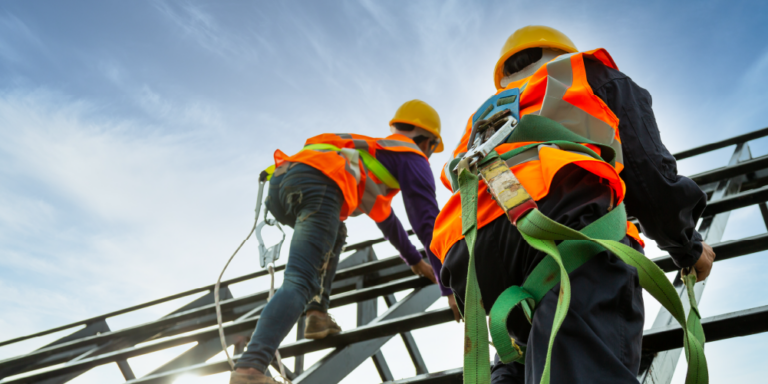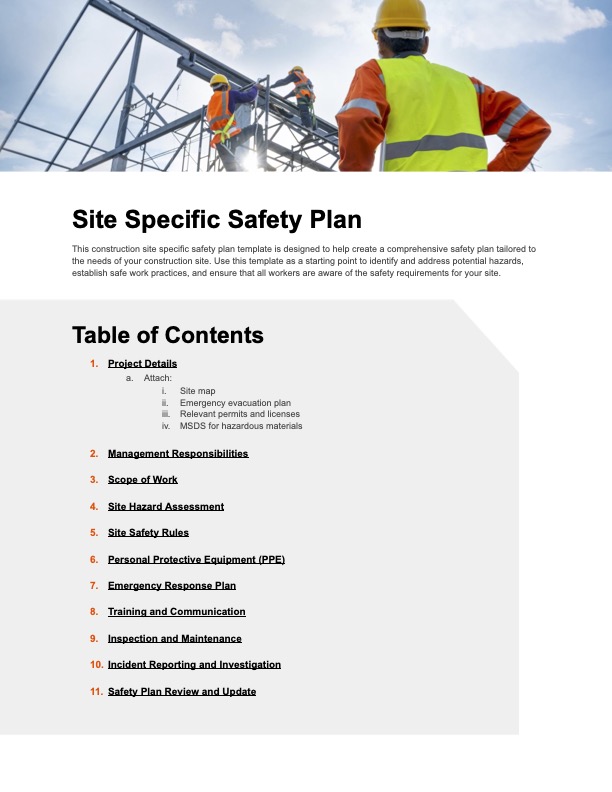— 8 min read
Site Specific Safety Plans: What to Include — and Why They’re Important

Last Updated Sep 1, 2024

Elizabeth Rivelli
Contributing Writer
12 articles
Elizabeth Rivelli is a freelance writer specializing in insurance and finance. Her writing has been featured in dozens of publications, including Investopedia, The Balance, Forbes, Bankrate, NextAdvisor, and Insurance.com. Elizabeth holds a degree in Communication Studies from Northeastern University. She lives in New England.

Clark Jensen
Strategic Product Consultant, Quality & Safety
10 articles
Clark Jensen joined Procore as a Senior Strategic Product Consultant, Quality & Safety where he spearheads product knowledge education and executes product demonstrations. He brings several years of experience in roles both on and offsite as a former senior project safety manager for a general contractor in Salt Lake City, and a senior risk control consultant for a large U.S.-based insurance firm.
Last Updated Sep 1, 2024

When starting a new construction project, it’s important for workers to be aware of potential safety hazards. Falls, slips, and trips are some of the biggest risks that construction workers can face.
In 2020, more than 1 in 5 workplace deaths happened in the construction industry. According to the Bureau of Labor Statistics (BLS), the construction industry accounted for more than 46% of all fatal falls, slips, and trip incidents that year.
Adhering to a site specific safety plan could save construction workers from the hassle of additional reporting, safety stand downs, and worker injuries. Read on to learn more about what a site specific safety plan is, what to include in the plan, and how to create an efficient plan that keeps workers safe on the jobsite.
Table of contents
What is a site specific safety plan?
A site-specific safety plan, or SSSP, is a comprehensive plan prepared for a specific construction site that outlines the scope of work on a project, identifies risks, and details company policies and safety practices to follow.
The main purpose of an SSSP is to identify potential hazards — and ensure the safety of anyone involved with the project. For example, the SSSP creator must identify what types of equipment will be used onsite, and what risks that equipment could pose to both workers and other people in the area of the jobsite.
The person responsible for creating the SSSP depends on the construction company. In some cases, the safety director or other designated safety professional will be in charge of the plan. In other companies, the general superintendent makes and implements the plan.
The SSSP is also used to prevent construction site accidents and injuries. For instance, if there will be a tower crane used on the job site, the SSSP should note how the building materials will be safely dropped off and stored to reduce the chance of a worker getting hurt.
How does a site specific safety plan work?
At the start of a new construction project, the owner or architect may request an SSSP from the construction company that will be performing the work. Once the plan is created, it gets presented to the owner or architect, who will either approve or deny the plan.
After the SSSP has been approved, the information in the SSSP is disseminated to everyone who comes to the job site through an orientation process. During site orientation, workers learn about the scope of work that will be performed, potential safety hazards, and protocols to avoid injuries and accidents.
In many cases, an individual can only enter the job site once they have completed site orientation. Depending on the project and the construction company, site orientations can be a formal in-person training or an informal process where the worker reviews the information on their own.
If something happens during the course of the project — like a worker getting injured — the SSSP can be revised. The new site specific safety plan will include any new hazards and the proper protocol to keep site workers safe.
Courses about construction.
For construction.
Unlock your career potential with our free educational courses on Health & Safety, Data in Construction, and more.
What should be included in a site specific safety plan?
To create an effective SSSP, it’s important to include a variety of different safety practices, policies, and controls. The SSSP should also include basic information and expectations for the project. Here are some of the things that should be included in a site specific health and safety plan.
Type of project
An SSSP should have details about the type of project you’re working on, including whether it’s commercial- or infrastructure-based, the total square footage of the building, and the number of floors in the building.
Scope of work
The scope of work will include things like the anticipated project start and end date, which construction teams will be onsite, what equipment will be used, and potentially, a timeline of deliverables.
Contact information
Include a contact list in the SSSP. This should include the names and phone numbers of the safety director, general contractor, site supervisor, foreman, project manager, and anyone else who has a role overseeing the project.
Project location
The SSSP will need to include the project location, including the physical address. All workers should know the project location in case of an emergency on the job site.
Geographic risks
An SSSP should include potential catastrophic events that are specific to the region. For instance, if the project is taking place in the southern United States, it’s important to include an overview of how a hurricane or flood could affect the project, and how to respond in the event of a natural disaster.
Site drawings with hazard locations
The safety director should include maps and site drawings in the SSSP that indicate potentially hazardous locations. There should also be instructions for how to avoid injuries when workers are in, or near, those areas.
Procedures to avoid hazards
In this section of the SSSP, there should be a detailed overview of the different policies and procedures that workers must follow to avoid accidents and injuries. These may be existing construction company procedures or new protocols created for the specific project.
Safety check schedule
If there will be daily or weekly safety checks on the job site, the SSSP should include when those safety checks will happen and what specifically will be checked (personal protective equipment, etc.)
Learn more: How to Write a Construction Safety Report
Accident investigation process
In the event of an accident on the jobsite, it’s important to include the accident investigation process in the SSSP. Also, mention what types of incidents need to be reported, and how workers should report them.
PPE guidelines
It’s likely that workers will be using personal protective equipment (PPE) on the jobsite. In the SSSP, make a note of the PPE guidelines, including what PPE is required for workers and if there are special requirements when operating certain machinery.
First aid locations
The locations of first aid kits should be included in the SSSP’s explanation of what to do in case someone on the jobsite is injured. You should also list the nearest hospital in case someone on the jobsite needs more serious medical attention.
Hazard communication plan
If there’s a serious emergency situation on the jobsite, like a chemical spill or natural disaster, it’s important to have a communication plan, which should be included in the SSSP. This section of the plan should have an emergency call tree, information on muster sites, and procedures for making sure that all workers are accounted for.
Free Download
Site Specific Safety Plan Template
Customize your own site specific safety plan with sections for common hazards and steps to mitigate and prevent future risks.
- Free starter template
- Ready-to-use
- Made for construction professionals


OSHA requirements for site specific safety plans
The Occupational Safety and Health Administration (OSHA) doesn’t always require construction companies to create an SSSP before starting a new project. However, there are some instances where OSHA does require a written safety plan.
For example, a written SSSP might be required if workers are handling hazardous substances, doing hot work, entering confined spaces, working at heights, or when there’s a risk of bloodborne pathogen exposure.
In addition, OSHA requires that all construction companies have a written emergency action plan, fire prevention plan, and hazard communication plan. These plans can be separate from an SSSP, but OSHA strongly recommends that companies create a written safety training and education program.
How digital site specific safety plans improve job site safety
There’s no right or wrong way to create a site specific safety plan, as long as it's comprehensive and contains the most important safety information that workers need to know. However, there are benefits to making a digital SSSP using construction software. Here are several reasons to consider using software to make your SSSP:
- See plan updates in real-time: When you use construction software, you can edit your SSSP and see the updates in real time. This makes it easier to communicate updates or changes to your construction teams.
- Improved visibility across project stakeholders: It’s important for project stakeholders, like owners and architects, to have easy access to the SSSP at all times. When you use construction software, everyone involved in the project can access the latest version of the plan at the office or at the job site.
- Streamlined communication: Having a digital SSSP can also improve communication between teams. It allows workers to ask questions about the plan without having to find a project manager or safety director in person.
- Access to historical data: If something goes wrong at a job site, using construction software allows you to record the incident and document what happened. When you start a new project, you can look back on that historical data to create your new SSSP. This also helps project managers to predict hazards and identify problem areas.
All project stakeholders should know the site specific safety plan
Having a site specific safety plan is a helpful way to promote safety on a construction site. Not only does a SSSP help workers identify potential risks before starting the project, but it also ensures that everyone on the job site understands the safety procedures and situational protocols in case of an emergency.
Once the SSSP has been created, it should be shared with key project stakeholders before the work begins. If any revisions are necessary, they can be added before workers go through orientation to learn about the safety risks and other information in the SSSP.
Make sure to also keep the SSSP updated for future projects. Using construction software to create your SSSP makes it easy to track historical data which can serve as a reference when writing new safety plans.
this is part of the series
Construction Safety Basics
Was this article helpful?
Thank you for your submission.
95%
5%
You voted that this article was . Was this a mistake? If so, change your vote
Scroll less, learn more about construction.
Subscribe to The Blueprint, Procore’s construction newsletter, to get content from industry experts delivered straight to your inbox.
By clicking this button, you agree to our Privacy Notice and Terms of Service.
Thank you!
You’re signed up to receive The Blueprint newsletter from Procore. You can unsubscribe at any time.
Categories:
Written by

Elizabeth Rivelli
Contributing Writer
12 articles
Elizabeth Rivelli is a freelance writer specializing in insurance and finance. Her writing has been featured in dozens of publications, including Investopedia, The Balance, Forbes, Bankrate, NextAdvisor, and Insurance.com. Elizabeth holds a degree in Communication Studies from Northeastern University. She lives in New England.
View profileReviewed by

Clark Jensen
Strategic Product Consultant, Quality & Safety | Procore
10 articles
Clark Jensen joined Procore as a Senior Strategic Product Consultant, Quality & Safety where he spearheads product knowledge education and executes product demonstrations. He brings several years of experience in roles both on and offsite as a former senior project safety manager for a general contractor in Salt Lake City, and a senior risk control consultant for a large U.S.-based insurance firm.
View profileExplore more helpful resources

Why Don’t We Protect the Whole Person?
Behind every safety incident is a person — and behind that person is a story we rarely ask about. Were they already exhausted before they arrived on site? Did they...

What Drives Better Safety Outcomes—Carrot, Stick, or “Zero Harm”?
On paper, construction has never looked safer. In reality, mental health claims are rising, workers are disengaged and the compliance playbook is broken. Garry Mansfield, co-founder of Scratchie, argues the...

How Close Are We to Bridging the Design-Build Divide?
For decades, construction decisions have often been made based on gut instinct. But what if the real barrier to transformation isn’t technology—it’s the divide between design and construction? In episode...

Gain Without Pain: Leveraging Technology for Strategic Safety Programs
In safety, there is always room for improvement, and technology creates the ability to scale safety programs that drive risk mitigation, operational efficiencies and competitive advantage. In fact, builders who...
Free Tools
Calculators
Use our calculators to estimate the cost of construction materials for your next project.
Templates
Find a template to help you with your construction project tasks.
Material Price Tracker
Get the latest U.S. retail prices and view historical trends for common building materials.
Glossary
Explore key terms and phrases used in the industry.
